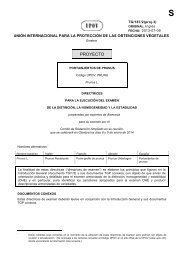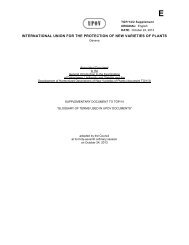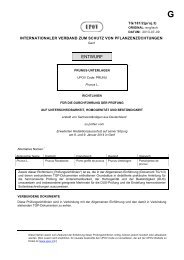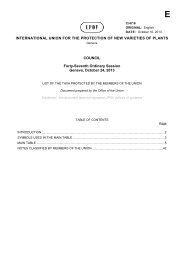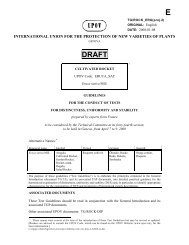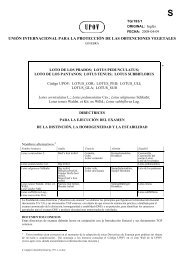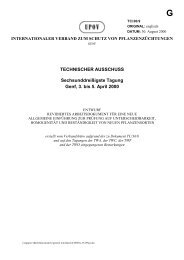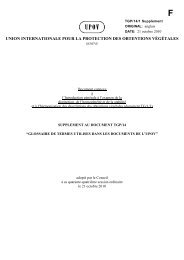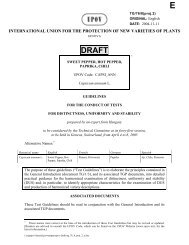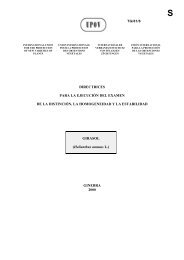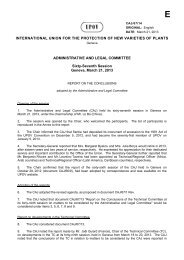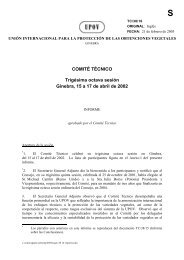E - International Union for the Protection of New Varieties of Plants
E - International Union for the Protection of New Varieties of Plants
E - International Union for the Protection of New Varieties of Plants
Create successful ePaper yourself
Turn your PDF publications into a flip-book with our unique Google optimized e-Paper software.
TGP/14/1: Section 3: Statistical Terms<br />
page 86<br />
Pooled Variance: Weighted average <strong>of</strong> a number <strong>of</strong> variances.<br />
Population: A population consists <strong>of</strong> an entire set <strong>of</strong> objects, observations, or scores that<br />
have something in common. The distribution <strong>of</strong> a population can be described by several<br />
parameters such as <strong>the</strong> mean and standard deviation. Estimates <strong>of</strong> <strong>the</strong>se parameters taken from<br />
a sample are called statistics.<br />
Population standard: The maximum percentage <strong>of</strong> <strong>of</strong>f-types that would be permitted if all<br />
individuals <strong>of</strong> <strong>the</strong> variety could be examined. (See document TGP/8: Part II, Section 8 “The<br />
Method <strong>of</strong> Uni<strong>for</strong>mity Assessment on <strong>the</strong> Basis <strong>of</strong> Off-types).<br />
Power: Power is <strong>the</strong> probability <strong>of</strong> correctly rejecting a false null hypo<strong>the</strong>sis. Power is<br />
<strong>the</strong>re<strong>for</strong>e defined as: 1 - where is <strong>the</strong> Type II error probability. If <strong>the</strong> power <strong>of</strong> an<br />
experiment is low, <strong>the</strong>n <strong>the</strong>re is a good chance that <strong>the</strong> experiment will be inconclusive. That<br />
is why it is so important to consider power in <strong>the</strong> design <strong>of</strong> experiments. There are methods<br />
<strong>for</strong> estimating <strong>the</strong> power <strong>of</strong> an experiment be<strong>for</strong>e <strong>the</strong> experiment is conducted. If <strong>the</strong> power is<br />
too low, <strong>the</strong>n <strong>the</strong> experiment can be redesigned by changing one <strong>of</strong> <strong>the</strong> factors that determine<br />
power.<br />
Precision: also called reproducibility or repeatability, is a term applied to <strong>the</strong> likely spread <strong>of</strong><br />
estimates <strong>of</strong> a parameter in a statistical model. Thus it expresses <strong>the</strong> extent to which fur<strong>the</strong>r<br />
estimates will show <strong>the</strong> same or similar results. It is measured by <strong>the</strong> standard error <strong>of</strong> <strong>the</strong><br />
estimator.<br />
Predicted Values: see prediction.<br />
Prediction: For a given set <strong>of</strong> values <strong>for</strong> <strong>the</strong> explanatory variables <strong>of</strong> a model, <strong>the</strong> prediction,<br />
or predicted value, is <strong>the</strong> value <strong>of</strong> <strong>the</strong> response variable that is predicted by a statistical model.<br />
See also statistical model.<br />
Probability Value: In hypo<strong>the</strong>sis testing, <strong>the</strong> probability value is <strong>the</strong> probability <strong>of</strong> obtaining<br />
a statistic as different from or more different from <strong>the</strong> parameter specified in <strong>the</strong> null<br />
hypo<strong>the</strong>sis as <strong>the</strong> statistic obtained in <strong>the</strong> experiment. The probability value is computed<br />
assuming <strong>the</strong> null hypo<strong>the</strong>sis is true. If <strong>the</strong> probability value is below <strong>the</strong> significance level<br />
<strong>the</strong>n <strong>the</strong> null hypo<strong>the</strong>sis is rejected. The probability value is also known as <strong>the</strong> significance<br />
probability.<br />
P-Value: See Probability Value.<br />
Qualitative Variable: see Variable.<br />
Quantitative Variable: see Variable.<br />
Random Sampling: In random sampling, each item or element <strong>of</strong> <strong>the</strong> population has an<br />
equal chance <strong>of</strong> being chosen at each draw. A sample is random if <strong>the</strong> method <strong>for</strong> obtaining<br />
<strong>the</strong> sample meets <strong>the</strong> criterion <strong>of</strong> randomness (each element having an equal chance at each<br />
draw). The actual composition <strong>of</strong> <strong>the</strong> sample itself does not determine whe<strong>the</strong>r or not it was a<br />
random sample.



